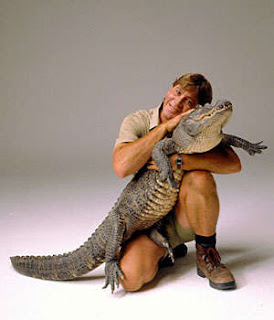I bet you thought you were going to get away without having to read a fact of the day. Sorry, no such luck for you or for me. Unfortunately, I didn't get to visit today's featured animal, which is the Nile Crocodile. If you are wondering why I decided that I have to do the crocodile today, it's because today is Saint Patrick's Day, and crocodiles are the only greenish animals I could think of.
 |
| Nile Crocodile's Range |
The Nile Crocodile, or the Crocodylus niloticus, is the largest crocodilian in Africa. It has a ferocious reputation as a creature of indiscriminate carnivorous taste. The males can measure anywhere from 11.5 to 16 feet long, and the old fellows can even reach more than 18 feet. The females are slightly smaller, typically measuring 8 to 13 feet long. The Nile Crocodile typically weights around 500 pounds, although larger guys can weigh up to 1,600 pounds. The largest living crocodile is purported to be a man-eater from Burundi (good news for me in South Africa) named Gustave, who is said to be 20 feet long. Unfortunately, Gustave isn't the only Croc who doesn't mind a bit of human in his diet; up to 200 people may die each year in the powerful jaws of the Nile Crocodile.
Nile crocs have a scaly hide with rows of ossified scutes running down the back and tail. Nictitating membranes protect their eyes, which are situated on top of their head along with their nostrils and ears. The nostrils, ears and eyes are on top of the head so that the rest of the body can remain concealed underwater. They normally crawl on the bellies, but they can also "high walk" with their upper bodies raised above the ground. Even large crocs can reach surprising speeds of up to 8.5 mph on land. In the water, they can move even faster, getting up to 22 miles per hour. In other words, don't go swimming in Africa's rivers because there isn't a chance for you (or me) to out-swim these guys. They can remain under water for up to 30 minutes if threatened, and if they stay inactive they can actually hold their breath for 2 hours.
 |
| Scutes |
Their mouths have 64-68 cone-shaped chompers. Younger crocs use these teeth to eat insects, fish, amphibians, small reptiles, and small aquatic invertebrates. Juveniles and subadults take on birds and small-to-mid-sized mammals. The adults like to nom gazelles, antelope, waterbuck, wildebeest, zebra, warthog, young hippos, giraffe, Cape buffalos, and even young elephants. They also will prey on humans whenever the opportunity presents itself. Although it is uncommon, crocs can hunt in packs, or "floats", of up to five animals, which can lead to the capture of a fully grown hippo or even the Black Rhino.
Baby crocs are 12 inches long. The new mother will protect her babies for up to two years, and during this time she may pick up her offspring in her mouth or gular (throat pouch) to keep them safe. Turtles and snakes will feed on them. When they babies reach a length of 4 feet, they leave the safety of their mother and set out on their own. Crocodiles have an average life span of 70-100 years.
CHEETAH TIME!!!
A cheetah's tail can reach up to 36 inches in length, and it acts as a stabilizer or rudder while the cheetah is running and turning at very high speeds.

























No comments:
Post a Comment